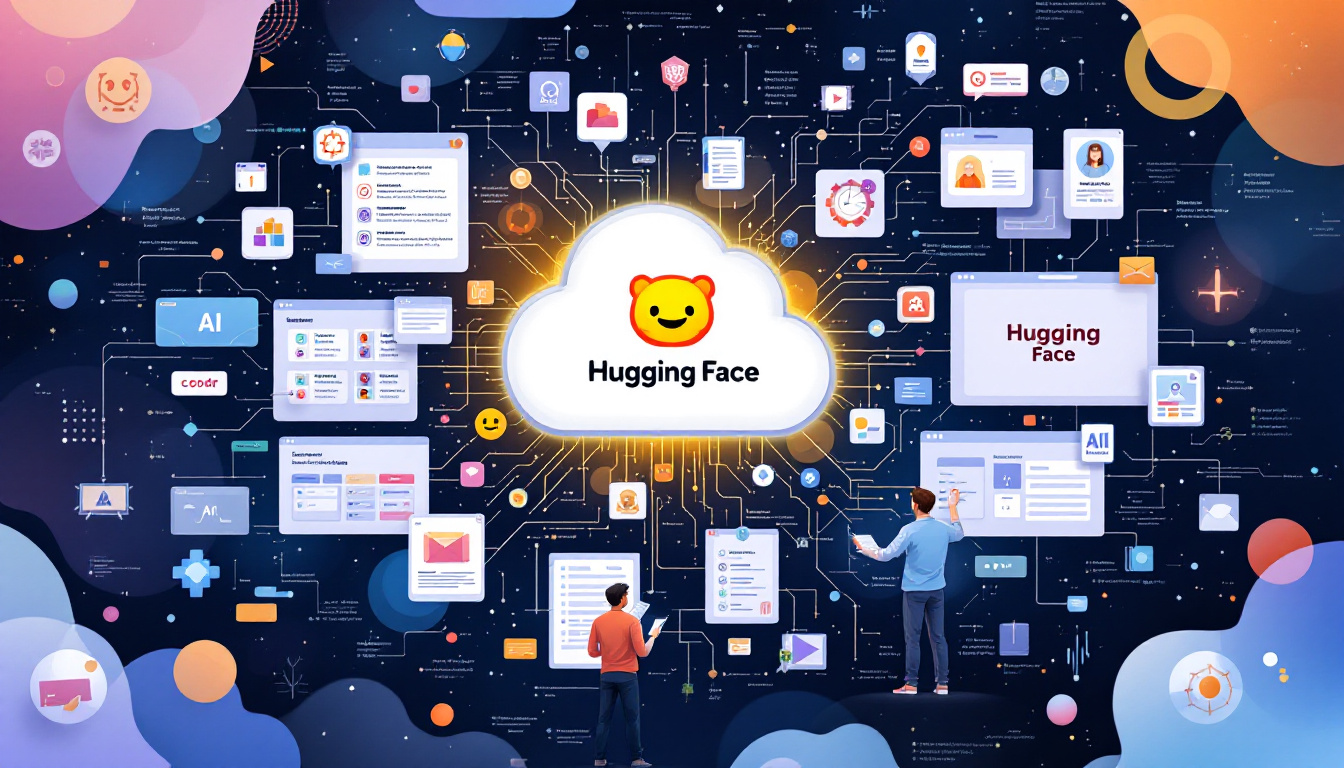If you’ve spent any time around machine learning or natural language processing, you’ve likely heard of Hugging Face. It’s become the go-to spot for tools, models, and a thriving community eager to shape the future of AI. Still, even as Hugging Face gains wide adoption with developers and researchers, myths and half-truths linger about what the platform can (and can’t) do.
Curious newcomers and seasoned pros alike bump into all sorts of stories—from exaggerated tech claims to confusion about the platform’s openness or community purpose. It’s easy to get swept up in the noise. This guide shines a light on the real Hugging Face, so you can separate fact from fiction and get the most out of what this platform truly offers. If you care about building, using, or just understanding modern AI, it pays to know what’s myth and what’s meaningful here.
Myth 1: Hugging Face is Just a Model Hosting Platform

Image created with AI
It’s easy to think of Hugging Face as a digital parking lot for machine learning models. So many headlines and product summaries focus on storage, as if all that happens here is a quick upload and a download link. But if you’ve only seen Hugging Face as a model warehouse, you’re missing the real action. This space hums with tools for data preparation, model training, deployment, and above all, a heartbeat of community-driven innovation. The platform supports every part of the process, not just the finish line.
Hugging Face’s Ecosystem is Vast
On the surface, uploading and sharing models is a core feature—sure. But there’s so much more waiting underneath the hood. If you peel back the layers, you’ll find an interconnected toolkit that helps users at every step of the AI workflow.
Here’s what you’ll actually discover when you look beyond storage:
- Data and Datasets: Not just a shelf for storing files. Hugging Face provides robust datasets and data management tools, empowering you to prep, share, and version information for training and evaluation.
- Transformers Library: The flagship Transformers library gives you access to widely used, pre-trained models for tasks ranging from text generation to translation, with straightforward fine-tuning to suit your needs.
- Pipelines for Common Tasks: Instead of writing boilerplate for every NLP or vision task, pipelines let you plug in your data and get immediate answers—think text summarization, sentiment analysis, or image classification.
- Collaborative Features: Model cards, spaces, and notebooks allow for knowledge sharing, best-practice documentation, and hands-on collaboration. This supports transparency and helps everyone learn from shared results.
- Workflow Integration: Training tools and deployment options (including seamless integration with cloud services and real-time APIs) mean you get more than a static repo. The platform fits naturally into production development.
You’ll find all the details you need about hosting, sharing, and uploading on Hugging Face’s official model sharing guide. But the bigger story is the platform’s constant addition of features to foster open collaboration and reproducible science.
Why Community Changes Everything
Many AI platforms offer a place to publish models. What sets Hugging Face apart? People. Its culture is built on knowledge sharing, transparent documentation, and cross-team support.
How does this show up in reality?
- Model Cards and Documentation: Thoughtful model cards are encouraged, spelling out strengths, limitations, recommended uses, and ethical notes for each resource shared.
- Forums, Spaces, and Notebooks: The community builds tutorials, datasets, and apps that newcomers can actually use—from zero-shot classification demos to end-to-end training scripts.
- Best Practice from Real Projects: Instead of working in isolated silos, practitioners can improve on others’ work, get feedback, report bugs, and stay current via real-world examples.
If you want to see why Hugging Face is more than just a “giant GitHub for ML models,” scroll through their engaging community platform or explore deeper collaborative features in guides like the handy Spaces deployment walkthrough.
The heartbeat of Hugging Face is open collaboration and innovation. The hosting feature is convenient, but the community and ecosystem are what unlock the true value. If you’re involved in AI—beginners and experts alike—embracing these features can make your work smarter, faster, and more connected.
Myth 2: Hugging Face Models Are Only for Experts

Maybe you’ve heard it said that Hugging Face is just for people with advanced AI skills or deep math backgrounds. That couldn’t be further from the truth. Today, the platform opens its doors to newcomers, hobbyists, educators, and anyone curious about AI. Hugging Face builds user-friendly tools, clear documentation, and accessible resources so almost anyone can pick up a project and start experimenting.
Let’s break down why Hugging Face welcomes beginners as warmly as seasoned pros.
Tools Built for Real People, Not Just PhDs
If you imagine piles of complex code and research papers, take another look. Hugging Face offers approachable libraries and features that keep the learning curve friendly:
- Transformers Library: This is the heart of easy AI work. With just a few lines of Python, you can pull in state-of-the-art models for text, image, or audio. The quickstart tutorial lets you run your first pipeline within minutes.
- Inference Endpoints: No need to wrangle with servers or GPU clusters. With endpoints, you can deploy pre-trained models as ready-to-go APIs.
- Hugging Face Spaces: Spaces allow you to create and share web apps powered by models—no advanced dev skills required.
The best part? Most features have clear guides and “copy-paste” examples you can adapt right away.
Documentation and Community Support
Ever felt lost following a tutorial? Hugging Face’s commitment to documentation and an active community stands out:
- Step-by-Step Guides: Every major tool (from datasets to fine-tuning tasks) is backed by practical guides. These guides are written so someone brand new to AI can follow along.
- Beginner Forums: The team hosts helpful discussions where newcomers get advice, encouragement, and answers. If you’re unsure about where to start, you’re not alone—check out real conversations in forums like Should I Be Here? – Beginners.
- Starter Tutorials: If “beginner friendly” makes you roll your eyes, you might be surprised. Tutorials such as Getting Started With Hugging Face in 10 Minutes reveal just how practical and down-to-earth this community can be.
Empowering Learners With Educational Resources
Learning should be hands-on, not overwhelming. Hugging Face curates a library of educational material so you can take your first steps with confidence:
- Interactive Notebooks: Launch a Colab notebook and test out a model right away, without any tricky installations.
- Video Walkthroughs: For visual learners, plenty of introductory videos and walkthroughs guide you every step of the way.
- Sample Projects: See how someone built a chatbot or translation tool? Tweak their code, change the dataset, and you’ll see results instantly.
Low-Code and No-Code AI Tools
You don’t need to write everything from scratch. Hugging Face now offers tools that let you explore AI with little to no coding:
- Pipeline Widgets: Just supply your input text in a web form—get an instant result, no code needed.
- Spaces Gallery: Browse ready-made apps for inspiration and test-drive models directly in your browser.
The Bottom Line: AI for Everyone
This platform is all about breaking down barriers. Whether you’re exploring for the first time or guiding a classroom, you’ll discover that Hugging Face brings advanced AI to everyone’s fingertips. If you want a place where curiosity leads to real results—no PhD required—Hugging Face is ready for you. For a true beginner’s perspective, take a look at What Is Hugging Face? A Complete Guide for Beginners.
You don’t have to be an expert to use AI tools. Just bring your questions and let the Hugging Face community help you on your way.
Myth 3: Hugging Face Is Just About Transformers

Image created with AI
Some folks still think Hugging Face is just about transformer models. That idea sticks around, probably because the Transformers library put Hugging Face on the map for a lot of people. But the platform isn’t built for one model type or a single type of problem. Instead, it’s become the go-to spot for all sorts of AI needs—from computer vision to speech, and even hybrid tasks that use more than one kind of data at a time.
If you’re looking for flexibility, you’re in the right place. Let’s unpack how Hugging Face continues to break out of the “just transformers” box and why this matters for your next project.
The Scope Goes Far Beyond Transformers
Transformers might feel like the star of the show, but they share the stage. Hugging Face supports a whole cast of AI models and tasks, making it a true hub for anyone working in machine learning.
You aren’t confined to just text processing or language work. Take a look at the platform’s wider reach:
- Vision Models: You’ll find state-of-the-art models for image classification, object detection, and segmentation. Training your own vision classifier or using a pre-built one is straightforward.
- Speech and Audio: Speech-to-text, speaker identification, and audio event detection are all included. This opens the door to projects like smart assistants, transcription tools, or even real-time translation.
- Multi-Modal AI: Modern projects often use data that blends text, images, and sound. Hugging Face provides out-of-the-box support here too, with models that juggle these inputs smoothly.
If you want a deep dive into the latest in vision-language models and experimental multi-modal reasoning, check out Hugging Face’s ongoing work in this field, as explored in their Vision Language Models (Better, faster, stronger) feature.
Practical Examples That Show the Variety
You don’t have to imagine how these tools fit together—concrete examples pop up every day across the community:
- Building an app that reads news aloud with expressive, natural speech.
- Training a system that can caption photos and make the experience accessible for everyone.
- Deploying a hybrid model that assesses product reviews using both images and written opinions.
These aren’t lab experiments. They’re real projects powered by Hugging Face’s flexible libraries and datasets.
Supporting Many Model Architectures
What really sets Hugging Face apart is its focus on making different types of AI work together. Transformers are just one option. The platform features:
- Interoperable Libraries: You can work with computer vision, speech recognition, and even 3D model generation without leaving the ecosystem.
- Unified Data Management: Organize, version, and share datasets easily, so you’re never stuck juggling files or notes across platforms.
- Simple Deployment: Package up a trained vision or speech model as a web API or embed it in an app, all without heavy engineering work.
This mix-and-match approach means you can move fast—no need to switch environments if you want to tackle a new problem. For a big-picture look at more use cases outside classic NLP, browse the impressive range of transformers for vision, audio, and multimodal AI on Medium.
Multimodal AI, Edge Applications, and The Push for Efficiency
The race isn’t just about bigger models anymore. Hugging Face is lining up with emerging trends: smarter and more efficient models (often smaller in size), new ways to run AI right on your device, and transparency through explainable AI.
Some highlights from recent advances:
- Lightweight models: You can now run powerful models on everyday laptops or phones, thanks to compression and efficiency upgrades.
- Edge AI: Deploy models locally for privacy—or just for speed.
- Explainability: Features that help you “see” how a model makes decisions, which is huge for trust and transparency.
- Multimodal models: AI that understands visuals, speech, and text together is now ready for everyday apps—not just academic demos. For instance, Hugging Face and partners like Microsoft are driving innovation in this area, bringing vision, audio, and more under one umbrella.
Why This Diversity Matters
Hugging Face isn’t just a home for transformers. It’s a clubhouse for everyone curious about AI, no matter the type of model or data. Whether you want to work with pictures, speech, or a mix of everything, the platform gives you the freedom and tools to build next-generation applications.
Open the door and you’ll see an ecosystem that’s broad, future-friendly, and focused on real solutions—far beyond what most people expect.
Myth 4: Open Source on Hugging Face Means Low Quality

Image generated by AI
People sometimes assume that anything “open source” is second-tier or not ready for business use—especially AI models shared on Hugging Face. The truth is almost the opposite: many of the world’s most reliable, flexible, and trusted AI tools are open source and hosted right on this platform. With constant peer review, community-driven updates, transparent processes, and public benchmarks, Hugging Face projects are often more robust than closed, “mystery box” alternatives.
Let’s tackle why this myth sticks around—and what actually builds trust in a tool.
Why Do People Doubt Open Source Quality?
Skepticism about open source isn’t new. Some folks picture hobbyist side projects, or think if software is “free to use,” it must be missing features, documentation, or quality control. The open source models on Hugging Face challenge these assumptions every day. They’re supported by entire communities, tested across industries, and constantly improved in real time.
Think about it this way: would you rather trust a tool tweaked by hundreds of people (across use cases, backgrounds, and industries) or just the handful inside one company? Here’s what makes Hugging Face stand out:
- Open Collaboration: Anyone can report issues, suggest fixes, and add improvements. This creates a living, breathing ecosystem.
- Transparency: You see the code, the data, and the model’s strengths and weaknesses. It’s not a black box.
- Peer Review: Frequent input means bugs get caught early, edge cases are addressed, and bias is easier to spot.
- Model Cards: Each model on Hugging Face features detailed documentation (a “model card”) outlining its origins, training data, intended uses, and limitations.
How Community and Peer Review Raise the Bar
Instead of one team making every decision, a global group of researchers and practitioners shape these models. That means:
- Issues get flagged quickly (sometimes within days or even hours).
- Updates and security patches are shared publicly.
- Real-world feedback from businesses, students, and even casual users fuels constant improvement.
Regular reviews catch more edge cases and push everyone to do better. If you need more specifics on how open source AI delivers at scale, consider reading how AI applications are scaled with open source Hugging Face models.
Rapid Innovation and Real-World Reliability
One hidden perk of open source? Speed. When a security bug pops up, or a faster algorithm arrives, open source communities can update models and libraries instantly—no waiting for a secret company patch. This “many hands make light work” approach powers much of modern AI.
A few standout benefits of Hugging Face’s open source model approach:
- Faster Fixes: Problems can be patched in hours, not weeks.
- Cross-Industry Validation: Models are posted, tested, and improved by users from medicine, finance, entertainment, research, and more.
- Production-Ready Examples: There’s a misconception that “open” means beta-quality only. In reality, top organizations run Hugging Face models in production every day. A detailed look at model usage in real-world deployments shows how this is possible; explore some concrete success stories on choosing the best open source LLMs for production.
The Real Advantages: Transparency, Trust, and Speed
If you’ve used closed AI products and wondered why something broke—or if they’re exposing hidden risks—you know how helpless that can feel. With Hugging Face open source projects, you’re never left guessing. You can audit the code, scan the training data, or review posted benchmarks.
Key takeaways:
- You’re never locked out of improvements or fixes.
- Feedback from all sorts of industries turns models from “pretty good” to truly reliable.
- Open source doesn’t mean basic; it means tested, transparent, and trusted.
Curious how teams are adopting these tools and tuning small models for enterprise use? There’s a thoughtful real-world breakdown in the CFM case study on open-source LLMs and Hugging Face.
So, if you hear that models on Hugging Face are “open source and low quality,” you can confidently correct the record. Open means visible, reliable, and truly ready for production—not the opposite.
Why Myth-Busting Matters for the AI Community

Image created with AI
Misinformation spreads quickly, especially in tech. When it comes to platforms like Hugging Face, a single rumor can shape how thousands approach artificial intelligence. Myths quietly influence who tries these tools, what projects teams attempt, and even how investors view the long-term promise of open-source AI. It’s easy to see the harm: folks avoid great resources, repeat old mistakes, and slow down the progress that benefits both experts and beginners.
Clearing up these myths isn’t just about setting the record straight. It directly benefits everyone who wants smarter, safer, and more open AI.
Misinformation Shuts Out Opportunity
When a myth goes unchecked, two things happen. People who might benefit from Hugging Face ignore it, thinking it’s not “for them.” On the other hand, decision-makers may hesitate to use the platform in real products, thinking open source equals risky or low quality. Reality is more optimistic. Platforms like Hugging Face are used every day in research, startups, schools, and major companies.
Just look at lively forums such as this practical Reddit thread where people swap tips and lessons from real-world projects. The more accessible the truth, the faster good ideas spread.
Myths Stall Progress and Creativity
Myths about Hugging Face don’t only hurt beginners. They also shape how seasoned engineers and teams approach new tasks. If you think it’s only “for transformers” or that “open source isn’t for production,” you skip entire categories of tools, features, and methods that save time and spark new ideas. The AI world runs by building on shared knowledge, and myths put up unnecessary walls.
- Developers may reinvent solutions already solved.
- Researchers miss out on peer-reviewed, community-tested models.
- Organizations might stick to slow, closed systems.
Speed matters. When the AI field works from facts, better models and tools reach everyone faster.
Clear Information Builds Trust
Trust is earned, not given. By busting myths, Hugging Face and its community show a commitment to transparency and quality. Real trust means more than “just working”—it’s about letting anyone see how things work, improve them, and share back.
Take the real discussion about Hugging Face’s strengths and risks, as covered in straightforward analysis like Belitsoft Unveils Hugging Face’s Hidden Production Risks. Honest conversations don’t create fear; they spark smarter choices and stronger solutions.
Why an Open Mind Pays Off
If you’ve avoided Hugging Face because of what you’ve heard, you’re probably missing out on serious advantages:
- A massive library of pretrained models and datasets
- Tools that match everything from quick experiments to enterprise deployments
- Community support, from basics to the latest research
The best way forward? Approach Hugging Face with a curious mindset. Try the tools. See how they fit your real needs. You might be surprised at how wrong the old myths really were.
Ready to dive deeper into how Hugging Face shapes real-world AI? The thoughtful deep dive on Hugging Face is a great next stop for practical insights and examples.
The bottom line: Busting myths doesn’t just help Hugging Face. It helps all of us build better, safer, and more creative AI—together.
Conclusion
Hugging Face isn’t just a storage locker for AI models, or an experts-only club, or a single-track library stuck on one type of model. It’s a broad platform where anyone—from curious beginners to seasoned teams—can build, share, and learn together. Open source doesn’t mean lower quality, either. In fact, it often means better tested, more transparent, and supported by a community that catches issues faster than any company alone.
The key takeaway? Most common claims about Hugging Face miss how much it has grown and how much value the community adds every day. Next time you hear a myth, question it—and share what you know. Dive in, ask questions, and join a global network working to make smarter, safer, and more open AI. Thanks for reading, and feel free to share your own thoughts or experiences below.

















